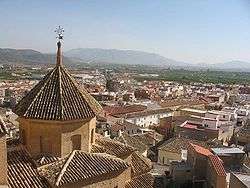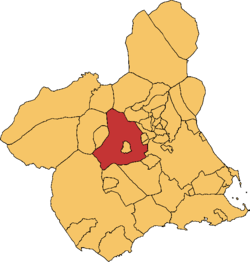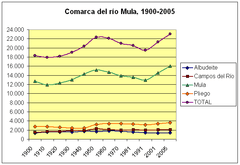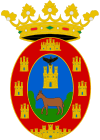Mula, Spain
- There is also a Mula in Murcia, Spain.
| Mula | |||
|---|---|---|---|
| Municipality | |||
 | |||
| |||
 | |||
 Mula Location in Spain | |||
| Coordinates: 38°3′N 1°30′W / 38.050°N 1.500°WCoordinates: 38°3′N 1°30′W / 38.050°N 1.500°W | |||
| Country |
| ||
| Autonomous community |
| ||
| Province | Murcia | ||
| Comarca | Río Mula | ||
| Judicial district | Mula | ||
| Founded | 713 (documented) | ||
| Government | |||
| • Mayor | José Iborra (2011) (PPRM-PP) | ||
| Area | |||
| • Total | 633.38 km2 (244.55 sq mi) | ||
| Elevation | 313 m (1,027 ft) | ||
| Highest elevation | 1,525 m (5,003 ft) | ||
| Population (2010) | |||
| • Total | 17,076 | ||
| • Density | 27/km2 (70/sq mi) | ||
| Demonym(s) | Muleños | ||
| Time zone | CET (UTC+1) | ||
| • Summer (DST) | CEST (UTC+2) | ||
| Postal code | 30170 | ||
| Website | Official website | ||
Mula is a municipality in the center of the autonomous community of Region of Murcia[1] in southeastern Spain, with nearly 17,076 inhabitants (2010, INE figures). It is best known for the tamboradas (drumming processions) held during the Holy Week. Tamboradas are a tradition in the area spanning the Murcian towns of Mula and Moratalla and the towns of Hellín and Baena in the provinces of Albacete and Córdoba, respectively.
Geography
The neighborhoods of Mula include Fuente Librilla, Yechar, Los Baños De Mula, Puebla De Mula y Casas Nuevas.
The municipality of Mula has the following neighboring municipalities:
- Calasparra, Cieza and Ricote to the North
- Ricote, Campos del Río, Albudeite, Alcantarilla and Murcia to the East
- Librilla, Alhama de Murcia and Totana to the South
- Bullas, Cehegín and Lorca to the West
- Pliego is completely surrounded by Mula.
Economy
The economy of Mula rests on dryland farming and ranching. Manufacturing in Mula is concentrated in the food and beverage sectors. The "El Arreaque" industrial park, to the east of the town center, was inaugurated in 2004.

Main sights
Religious buildings
Saint Michael's church (la Parroquia de San Miguel) is located in Mula's City Hall Square (La Plaza del ayuntamiento de Mula). With its two towers, including a clock tower, it forms a large monumental complex that often serves as the logo of the municipality. This church suffered near total destruction during the Spanish Civil War; only the entranceway was saved. The rest of the decorative paintings and sculptures were destroyed. It is known that the canopy of the old altar and the wall paintings were done in the Baroque style. It was quite tall for its era.
The church contains two chapels: to the right, the Chapel of Marquesa (marchioness) Vélez, and to the left, the Chapel of San Felipe. The latter chapel contains relics of the saint brought from Sicily by Marquesa Vélez in 1648.
This church has an art museum made possible by a donation from Doña Pilar de la Canal, widow of Don Pedro Luis Blaya, in 1940. It collection spans from the 16th to the 20th centuries.
Castle of the Vélez Family
The castle was mentioned by Al-Idrisi, a 12th-century traveler[2] and by King Alfonso X. In the 15th century it had a massive wall to the north.[3] There was one wall to protect the cisterns of the city and another wall to watch over the city's two parishes recently converted to Christianity; these walls remain.
The architecture of the castle is Renaissance in its defensive character and simple forms, situated over a crag of rock. Of the two entrances, one of them accedes better to the high part of the wall and the towers of the old Muslim fortress in addition to a drawbridge. It contains four differentiating elements: the torre del homenaje, a central nave with a barrel vault, a structure semidetached from the nave and a cistern. The cistern is an indication of Muslim influence because it is an essential element of a mosque.
Museums
- "El Cigarralejo". In this museum are exhibited the remains, ceramics, and utensils of the Iberian epoch, which have been taken out from the ruins of a town, necropolis, and sanctuary of that time.[4]
- Casa Pintada (many-colored house): The museum is located in a Renaissance palace, and contains a collection of many of the works of Cristobal Gabarrón.
- The "Castle of Alcalá" or castle of La Puebla, situated on a hill near the La Puebla district. The castle is Muslim and is characterized by a gateway and the cisterns that supplied the water to the city.
Culture
National contest of rapid painting
This is called each year on the second Sunday of November, coinciding with the Craft Bazaar "Las 4 Plazas". On the first occasion (November 11, 2007) 114 painters, coming from all over Spain, met on a sunny, spring-like day. It was in every way a success that did not distance the residents and visitors, given the beauty and variety of places that Mula possesses. It was one more occasion to visit this historic and welcoming Murcian city.
Spanish Film Week
Since 1988 the "Segundo de Chomón Cinema Club" has been coming together as a denominational competition of the Spanish Film Week, and since 1993 the National Contest of Film Shorts. Both events are now obligatory appointments of the aficionados of the seventh art, each year in spring. It's an occasion to benefit from the actors, directors, and invitations to enjoy the historic resources, cultural inheritance, excellent temperature, and partake of the rich gastronomy of the region.[5]
Sports
In sports, Mula counts some swimming pools, situated around the football field. Mula has two municipal football fields (one of grass and the other waits to become artificial). There is a football pavilion, hall, "Grand Route" and a sports center with another pavilion, an outdoor pool, and tennis and basketball courts.
Festivals
The Night of the Drums
The origin of the playing of the drum in Mula is difficult to narrow down, but it seems to have taken place during the 14th century, as a form of protest. It is not presently clear that the first mention written that we have of the playing of the drum through the streets of Mula go back to the municipal ordinances of 1859, where it is written that only those persons authorized through the Brotherhood of Carmen were allowed to go through the streets with drums, and only in the procession. For this reason it is supposed that already at that time in the Holy Week of that year the people went out to play drums through the streets.
It is believed that this tradition of playing drums comes from the beginnings of the fourteenth century. It is possible to think that through the ages in which the playing of the drum in this locality, Holy Week, it could have been thought that it is a form of religious demonstration, but it is not at all the case that the people of Mula begin to play drums in protest at the restrictions and prohibitions imposed by the civil and catholic authorities in the locality.
On the night between the Holy Tuesday and the Holy Wednesday, in the plaza of the town hall, thousands of people dressed up in black tunics with huge drums congregate in and around the plaza outside the town hall. A few minutes before the clock strikes 12, the street lights in the plaza are dimmed and all goes silent. Suddenly all the drummers raise their hands above their heads and create a beat by banging their sticks together. A fanfare of trumpets join in and finalise the end of the introduction. A few seconds then pass and the ground begins to tremble and shake and you can feel the vibrations through your whole body as thousands of drums begin to play at once, the ground begins to tremble... and in this way begins the Night of the Drums of Mula.
The drummers don't stop the playing the drums for the whole night. MEan women and children march the streets all night beating upon their drums in a repetitive beat. The drumming continues into the next day and often after that.
The drum
The instrument is fabricated in a homemade form by craftsmen from Mula. The modern drum may have changed over the length of the years, perhaps losing something of the originality, taking many of the elements of the next town of Moratalla. But moving toward perfection in many perceptions.
The instruments, whose diameters seldom approached 45 centimeters, had a like complement of drumsticks with fine points, that served to drumroll and beat without great force. Now, the drum that is highly valued is that with large dimensions (55, 60 or 65 centimeters in diameter) and drumsticks with point in form of a "club" with which one can strike with force on the skin of the drum.
The method of manufacture of the drum also has changed. In the past it was not possible to commission a blacksmith for a box and screws. The people used their ingenuity with laths, to constitute the base of the drum. In those cases the skins were tightened using some holes punched in the rings and winding a cord to constrict them. The strings were made with intestines of animals. In the present day, the drums are made with a metallic box, screws to tighten and the strings are guitar cords.
Other celebrations
National Short Film Competition organized since 1993 by the Segundo de Chomón film club.
Easter and Semana Santa, along with Tamborada (Night of the Drums), declared of National Tourist Interest. Processions begin on Good Friday from the Church of San Miguel with the Via Crucis, and continue with the procession of Palm Sunday Morning from Santo Domingo church to meet Pedro Leon nude in the Town Hall Square. The parades continue on Holy Wednesday from the Chapel of Carmen, Holy Thursday the procession of Jesus of Nazareth, and late in night the procession of Christ of the Asylum, and the Good Friday procession of the Holy Burial, leaving these three processions from Santo Domingo. On Easter Sunday, the procession of the Risen Christ descends from the Royal Monastery of the Incarnation to the Town Hall Square where 9 processional thrones meet each other.
Fiestas de San Isidro on the second Saturday of May, in honor of San Isidro Labrador, patron of the garden and field, basis of the local economy. Procession with the saint from the church of Santo Domingo in the morning, accompanied by choirs and dance groups and locals dressed in traditional costumes, to the Town Hall Square where it develops the Market "The Four Squares". "Bando huertano" on afternoon with floats towed by agricultural machinery, barracks and buildings that emulate typical of the garden, with distribution of sausages and vegetables. At night, festival and concert in Fair Park, where the parade ends.
Fair and Festivals of September, beginning with the Descent of the image of gay Jesus Balate, September 8, from his Sanctuary to the Royal Monastery of the Incarnation, where the 11th is moved to the church of Santo Domingo for the Novena in his Honor. The Fair takes place from 19 to 25. Day 21 is celebrated the Feast of the Child Jesus, commemorating his appearance to the shepherd Fray Pedro de Jesus Botía in 1648, with morning religious services and evening procession through the streets of the city. 22, Pilgrimage to the return of the image to his temple, and cookouts around the sanctuary. On 23, the Feast of Our Lady of Carmen, with masses in the chapel and evening procession. 25, Feast of the Patron Saint Philip Martir, with evening religious service in the church of San Miguel followed by procession. These days is celebrated the week of Theatre and Craft Fair of the Shire.
Market "The Four Squares" the second Sunday of each month at City Hall Plaza, except the summer months.
Notable people
- Juan de la Cierva y Peñafiel, Spanish politician and lawyer
- Patric, footballer
- Pedro Leon, footballer
Notes
- ↑ Murcia is the only one of the 17 Autonomous Communities of Spain whose name includes the word "region".
- ↑ Emilio Molina, "Aproximación al estudio de Mula islámica"
- ↑ Don Juan González Castaño
- ↑ "M "El Cigarralejo" Monographic Museum of Iberian Art".
- ↑ Documento sin título
External links
| Wikisource has the text of the 1911 Encyclopædia Britannica article Mula. |
- El Portal de acceso a la Ciudad de Mula Nonofficial site (in Spanish)

